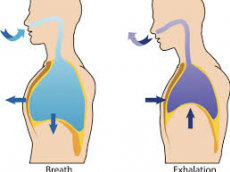

During an attack, excess mucus production clogs the airway, and tightening of muscles limits the volume of air able to enter the lungs. Blocked airflow intensifies the effort required to move air in and out of the lungs, hence the breathlessness. The aims of this experiment were to examine lung volumes and capacities, assessing tests of pulmonary function when breathing normally and through obstructed airflow.
The experimental procedure consists of a volunteer breathing into a mouth piece attached to a flow head. Nose clips are required to ensure breathing was only through the mouth. Lung volumes, and capacities are measured, using a spirometer, where the volunteer breathes normally. Measuring parameters of forced expiration consists of a comparison of normal breathing and forced breathing activities where the volunteer inhales maximally and exhales as rapidly and forcefully as possible. Asthma can be simulated through reducing the diameter of the mouth piece, then the volunteer repeats the pulmonary function test. Lung volumes and capacities can then be determined through calculations.
Differences in predicted and experimental values occurs due to the fact that the predicted vital capacity does not take other factors that will influence the value into consideration. For example, a person’s mass or ethnicity. Additionally, the predicted values are taken from an average of a large population, so the value will vary from person to person. The residual volume cannot be determined by ordinary spirometry as spirometry measures the volume of air moving in and out of the apparatus. When breathing, residual air will not leave the lungs and thus will not enter the apparatus to be detected.
Decreases in vital capacity can be due to inspiratory and expiratory muscle weakness. Slight differences in experimental values against spirometry extension values may occur due to human error, perhaps if the marker used to calculate it was not placed exactly in the correct position.
The pulmonary function tests with restricted airflow differ to those taken with normal breathing. In asthma, it would be expected that the forced vital capacity, forced expired volume in 1 second and the peak inspiratory and expiratory flow to be affected. This is because obstruction prevents airflow, so less air can move in and out in a given amount of time. Obstruction means that more effort is required to move the air through muscle contraction. During the simulated asthma attack, the volunteer experienced breathlessness and tightness in the chest. This makes the volunteer feel more exhausted and would struggle to do physical activity.
So, how do asthma inhalers work? Asthma pumps can contain various medications which act on constricted airways in the lungs. They are designed to relieve symptoms of shortness of breath and wheezing, albuterol can do so. Albuterol works by binding to beta-adrenergic receptors which are located on the surface of smooth muscle cells in our airways. The binding causes the smooth muscle cells to relax allowing more air to flow through. This is a short-term fixation. Another common medication is fluticasone. Fluticasone acts on small airways, decreasing inflammation. Medications are highly safe and effective, allowing asthma patients to live their everyday lives.
image-
https://www.medicalnewstoday.com/articles/319924.php

0 Comment:
Be the first one to comment on this article.